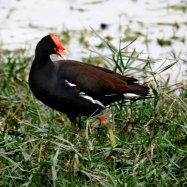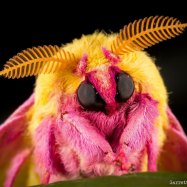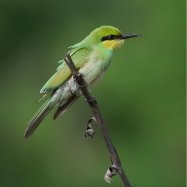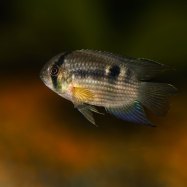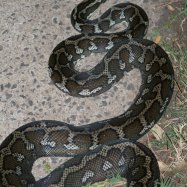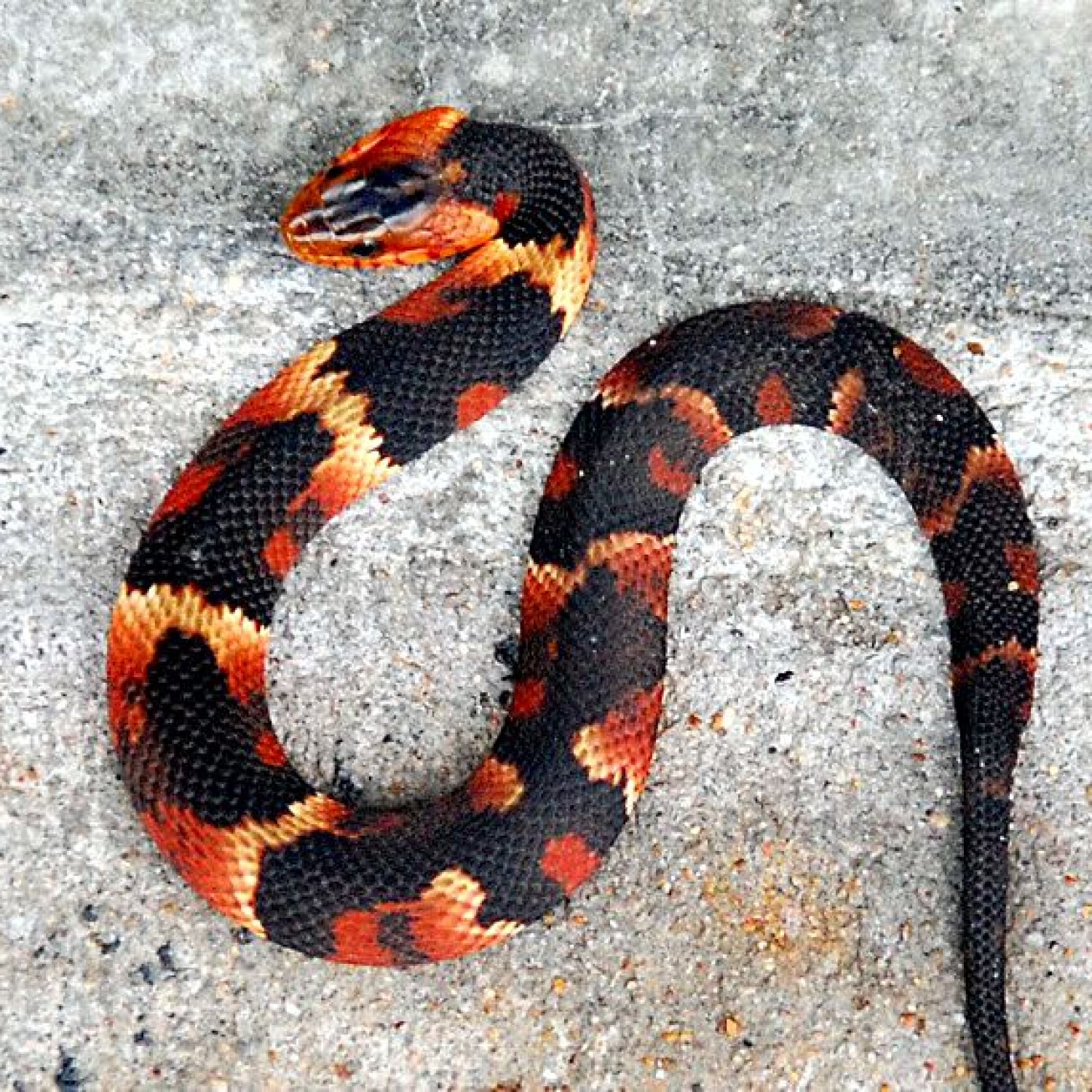
Banded Water Snake
24 to 42 inches (60 to 107 cm)
The Banded Water Snake, found in the Eastern United States, has a slender body and can grow up to 24-42 inches. Belonging to the Colubridae family, it's known for its distinctive banded pattern and is non-venomous. Keep an eye out for these fascinating creatures when exploring nature. #BandedWaterSnake #EasternUnitedStates #Colubridae
Animal Details Summary:
Common Name: Banded Water Snake
Kingdom: Animalia
Habitat: Freshwater habitats, including rivers, lakes, ponds, marshes, and swamps
The Fascinating Banded Water Snake: A Master of Aquatic Environments
As summer arrives and people flock to the water for relief from the heat, a common sight in the freshwater habitats of the eastern United States is the banded water snake, also known as Nerodia fasciata. This beautiful serpent has a unique appearance, feeding method, and habitat that make it a fascinating creature to study. In this article, we will explore the world of the banded water snake and uncover its interesting characteristics and behaviors.Finding the Banded Water Snake
The banded water snake can typically be found in freshwater habitats such as rivers, lakes, ponds, marshes, and swamps Banded Water Snake. They are commonly found in the eastern United States, with a range that spans from New Jersey all the way to Texas. These snakes can also be found in the Bahamas and the Turks and Caicos Islands. Due to their wide distribution, they are known by various common names, including water snake, southern water snake, and simply banded snake.While they can thrive in many aquatic environments, banded water snakes are most commonly found near slow-moving rivers and streams. They are also frequently seen in marshes, where they can easily blend in with the tall grasses and plants. In fact, these snakes are excellent swimmers and can often be found floating gracefully in the water, searching for their next meal.
The Master of Camouflage
The banded water snake is a master of camouflage, with a coloration and body shape that help it blend in seamlessly with its surroundings. Its body can vary from shades of brown, tan, or gray, with dark brown or black crossbands that give it its distinctive banded appearance. These crossbands often have irregular rows of white or yellow scales, adding to the snake's overall camouflage Bee Eater.The coloration of the banded water snake can also vary depending on its geographical location. For example, individuals in the northern regions of their range tend to have a reddish-brown color, while individuals in the southern regions have a more yellowish-tan color. This is due to adaptation to their respective habitats, where they can best blend in with their surroundings.
The Carnivorous Diet of the Banded Water Snake
Despite their name, banded water snakes are not strictly aquatic and will often venture onto land to hunt for prey. They are opportunistic feeders and will consume a wide variety of animals, including fish, frogs, salamanders, small mammals, and even other snakes. This makes them an important part of the ecosystem, as their diet helps control the populations of other animals in their habitat.Banded water snakes are constrictors, meaning they squeeze their prey to death before consuming it. They do not have venom like other snakes, so their feeding technique relies solely on their strong muscles. These snakes also have specialized teeth in the back of their mouth to puncture and hold onto their prey while they swallow it whole.
The Physical Characteristics of the Banded Water Snake
At first glance, the banded water snake may seem similar to other snake species, but upon closer inspection, its unique physical characteristics set it apart. These snakes have a slender body with a round cross-section, making it easier to navigate through the water. They also have keeled scales, which give their skin a rough texture, helping them grip onto prey and surfaces when swimming.Banded water snakes can range in size, with adult females typically growing larger than males. On average, they measure between 24 to 42 inches (60 to 107 cm) long, with the record length being 63 inches (160 cm). They have a relatively small head in proportion to their body and small, round eyes that are adapted for life in the water.
The Lifecycle of the Banded Water Snake
Banded water snakes mate in the spring and early summer, with females typically giving birth to live young between July and September. The females do not lay eggs but give birth to an average of 12 to 31 live snakelets, with the record being 83. The snakelets are born fully formed and independent, capable of fending for themselves from birth.These snakes can live up to 15 years in the wild, although the average lifespan is around 5 to 8 years. As they are not classified as a threatened species, their populations are stable and not a major concern for conservation.
The Importance of Banded Water Snakes
Banded water snakes play a vital role in their ecosystem, helping to control the populations of prey animals and providing a food source for other predators. They also have a unique adaptation to their aquatic habitat, with special glands in their skin that secrete a waxy substance to prevent excessive water loss.Furthermore, banded water snakes have helped researchers understand the effects of pollution on aquatic ecosystems. Due to their sensitivity to water quality, changes in their populations can serve as an indicator of environmental health.
In Conclusion
The banded water snake, with its unique appearance, feeding method, and habitat, has proven itself to be an exceptional creature. From its adaptability to its mastery of aquatic environments, this snake is truly remarkable. While some may fear these snakes, they play an essential role in our world, and we should take the time to appreciate and understand these fascinating creatures. So the next time you spot a banded water snake in the water, take a moment to observe its beauty and admire its remarkable abilities.

Banded Water Snake
Animal Details Banded Water Snake - Scientific Name: Nerodia fasciata
- Category: Animals B
- Scientific Name: Nerodia fasciata
- Common Name: Banded Water Snake
- Kingdom: Animalia
- Phylum: Chordata
- Class: Reptilia
- Order: Squamata
- Family: Colubridae
- Habitat: Freshwater habitats, including rivers, lakes, ponds, marshes, and swamps
- Feeding Method: Carnivorous
- Geographical Distribution: Eastern United States
- Country of Origin: United States
- Location: Eastern United States
- Animal Coloration: Brown, tan, or gray body with dark brown or black crossbands
- Body Shape: Slender body with a round cross-section
- Length: 24 to 42 inches (60 to 107 cm)
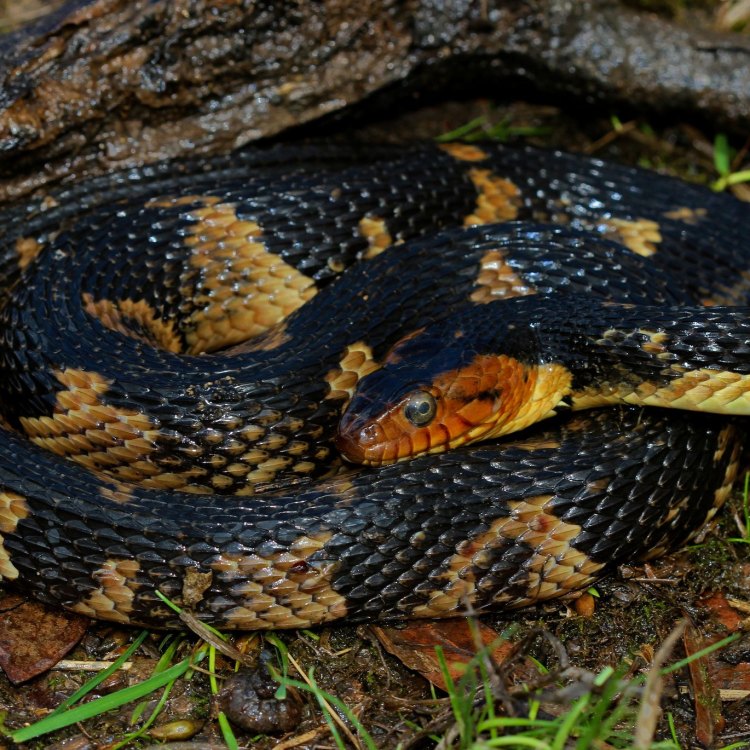
Banded Water Snake
- Adult Size: 24 to 42 inches (60 to 107 cm)
- Average Lifespan: 5 to 10 years
- Reproduction: Sexual
- Reproductive Behavior: Mating occurs in spring or early summer
- Sound or Call: No distinctive sound or call
- Migration Pattern: Non-migratory
- Social Groups: Solitary
- Behavior: Generally non-aggressive but may bite if threatened
- Threats: Habitat loss, pollution, and human persecution
- Conservation Status: Least Concern
- Impact on Ecosystem: Help control populations of small aquatic animals
- Human Use: Not used by humans
- Distinctive Features: Dark crossbands on body
- Interesting Facts: Banded Water Snakes are excellent swimmers and can even climb trees.
- Predator: Birds of prey, larger snakes, and mammals
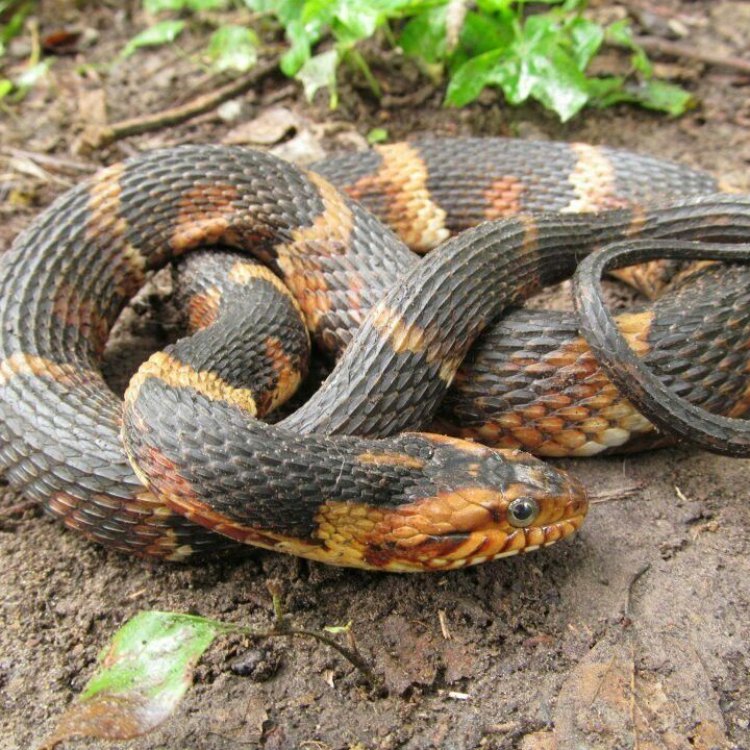
Nerodia fasciata
The Fascinating Banded Water Snake: A Master of Water and Land
Snakes have long been feared and misunderstood creatures, often portrayed as ruthless and venomous killers. However, not all snakes fit this stereotype, and one such example is the banded water snake. This intriguing species is not only unique in its appearance but also plays a vital role in its ecosystem. In this article, we will dive into the world of the banded water snake and discover its fascinating features, behavior, and impact on its environment PeaceOfAnimals.Com.An adult banded water snake can reach a size of 24 to 42 inches (60 to 107 cm), making it a medium-sized snake. They have a relatively long lifespan of 5 to 10 years, much longer than other species of snakes. These snakes have a slender body, with a distinctive pattern of dark crossbands on their body, which gives them their name. The crossbands vary in color from black, brown, or reddish-brown, and the lighter color in between the bands can range from yellow to orange. This distinctive pattern makes it easy to identify the banded water snake from other species that inhabit its range.
These non-venomous snakes are not only excellent swimmers but also skilled climbers. Despite their name, they are not restricted to water and can also be found on land, often in close proximity to freshwater sources. Their diet mainly consists of small aquatic animals such as frogs, fish, and crayfish. They are also known to prey upon rodents and small birds that live near the water's edge Barb.
The banded water snake's reproduction is sexual, and they engage in mating activities in the spring or early summer. During the mating season, the males will compete against each other for the females' attention, showcasing their strength and agility through a series of wrestling matches. The female will then select a suitor, and after mating successfully, she will lay a clutch of 6 to 20 eggs. These eggs are incubated for approximately two months before hatching.
Unlike some snake species that are solitary, banded water snakes have shown to exhibit social behavior by forming small groups. These groups are usually seen basking in the sun near the water's edge or hunting together for food. However, these social groups are not considered permanent, and the snakes often go back to being solitary creatures after the mating season is over.
These snakes are generally non-aggressive and will try to flee when encountered by humans. However, if they feel threatened, they may bite as a defense mechanism. The good news is that their bite is not harmful to humans, and it is even speculated that they may be immune to certain toxins from their prey.
Despite its name, the banded water snake is a non-migratory species. They are often found in the same habitats year-round, only moving to find fresh water and food sources when necessary. This makes them particularly vulnerable to habitat loss, which is one of the main threats they face. Destruction of their wetland habitats through development and pollution is a significant concern for their population.
Humans have also been known to persecute banded water snakes, often killing them if they are mistaken for venomous snakes or perceived as a threat. This fear and lack of understanding about these creatures have led to a decline in their population. Additionally, pollution in their habitats, particularly chemical runoff from agriculture, can be harmful to the snakes and the prey they consume.
According to the International Union for Conservation of Nature (IUCN), the banded water snake is currently listed as Least Concern on the conservation status list. This means that while they may face some threats, their population is currently stable. However, continued monitoring of their population and habitat is necessary to ensure their conservation.
One of the most significant contributions of the banded water snake to its ecosystem is its role in controlling the populations of small aquatic animals. They help maintain a balance in the food chain by preying on animals that may otherwise overpopulate and disrupt the ecosystem. This makes them an essential part of the food web and highlights their importance in the environment.
Despite their beneficial contributions to their ecosystem, banded water snakes are not used by humans. Unlike other snake species that are hunted for their skins or used for medicinal purposes, the banded water snake is not commercially exploited. This lack of human use has allowed the species to thrive without human interference, contributing to their stable population.
In addition to their distinctive physical features and unique behavior, banded water snakes also have some interesting facts that make them stand out. These snakes are not only excellent swimmers but also skilled climbers. They can climb trees near the water's edge, using their powerful muscles and rough scales to grip onto branches. This allows them to have access to a wider range of food sources and evade predators. Furthermore, their ability to swim and climb makes them versatile predators, able to hunt in water and on land.
Speaking of predators, banded water snakes have their fair share of foes in the animal kingdom. Their natural predators include birds of prey, larger snakes, and mammals such as raccoons and otters. These predators pose a constant threat to the banded water snake, highlighting the need for the species to adapt and evolve to survive in their environment.
In conclusion, the banded water snake is a remarkable creature that has adapted to thrive in both water and land. Despite facing threats such as habitat loss and human persecution, their population remains stable for now. As we continue to learn more about these creatures, it is essential to spread awareness and correct misconceptions about them. By understanding their unique features, behavior, and contribution to their ecosystem, we can work towards preserving their habitats and ensuring their continued existence in the wild.
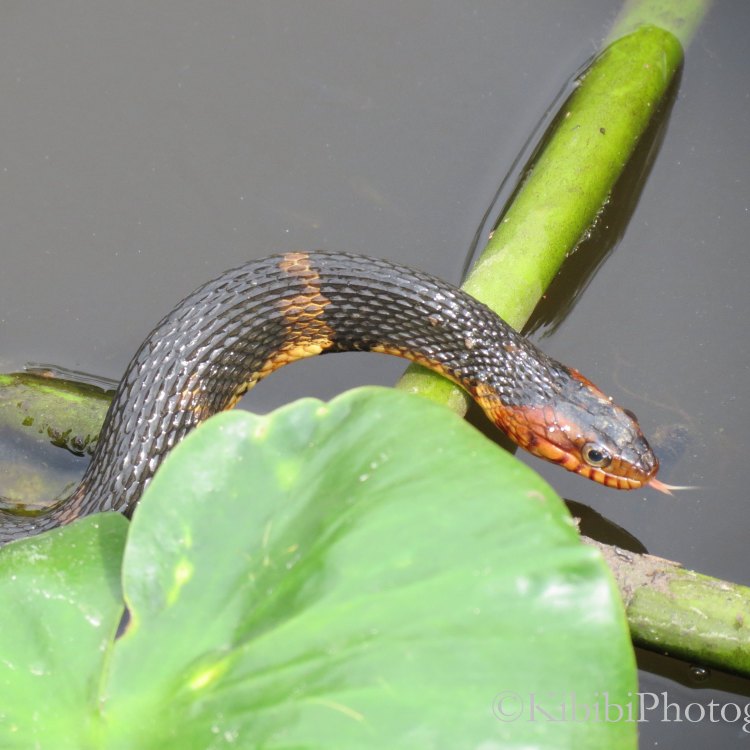
The Fascinating Banded Water Snake: A Master of Aquatic Environments
Disclaimer: The content provided is for informational purposes only. We cannot guarantee the accuracy of the information on this page 100%. All information provided here may change without prior notice.

